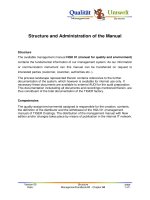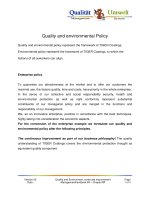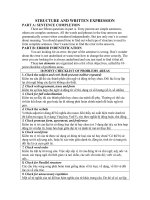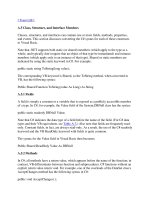Tài liệu STRUCTURE AND WRITTEN EXPRESSION docx
Bạn đang xem bản rút gọn của tài liệu. Xem và tải ngay bản đầy đủ của tài liệu tại đây (158.83 KB, 10 trang )
STRUCTURE AND WRITTEN EXPRESSION
PART A: SENTENCE COMPLETION
There are fifteen questions in part A. Forty percent are simple sentences,
others are complex sentences. All the words and phrases in the four answers are
grammatically correct when considered independently. But just only one’s is correct
about meaning. You should spend time to find out what type of structure is need to
form complete sentence. Don’t waste time to find the error in the answers.
PART B: ERROR INDENTIFICATION
You are looking for an error, the part of the sentence is wrong. Don’t wonder
about the error is not underlined or waste time how to change the error corectly. The
error you are looking for is always underlined and you just need to find it that all.
These ten elements are organized into a list of ten objectives, called the 10-
point checklist of problems areas.
10-POINT CHECKLIST OF PROBLEMS AREAS
1. Check the subject and verb (both present; neither repeated)
Kiểm tra câu đã đủ các thành phần chủ ngữ và động từ hay chưa. Đôi lúc là sự lặp
lại chủ ngữ bằng các đại từ không cần thiết.
2. Check verb agreement, tense and form
Kiểm tra sự hòa hợp chủ ngữ và động từ về thì, dạng và số lượng (số ít, số nhiều)
3. Check for full subordination
Kiểm tra sự đầy đủ các thành phần hay chưa của mệnh đề phụ. Thường có thể các
từ liên kết được rút gọn hoặc ẩn đi nhưng phải hoàn chỉnh mệnh đề hoặc ngữ rút
gọn.
4. Check the verbals
Verbals adjective dùng để bổ nghĩa cho noun. Khi thấy nó xuất hiện trước danh từ
thì kiểm tra ngay là ở dạng Ving hay Ved/V
II
tùy theo nghĩa bị động hoặc chủ động.
5. Check pronoun form, agreement, and freference
Kiểm tra vị trí của đại từ có đúng loại đại từ hay chưa (có 5 dạng đại từ), sự hòa hợp
động từ với đại từ, hoặc hòa hợp giữa đại từ và danh từ mà nó thay thế.
6. Check word form
Kiểm tra vị trí của từ được sử dụng có đúng từ loại của nó hay chưa? Có thể bị sử
dụng sai từ adj sang adv, hoặc bị xáo trộn giữa danh từ, động từ, tính từ và trạng từ;
đôi lúc là cả cụm giới từ.
7. Check word order
Kiểm tra trật tự từ trong câu. Việc sắp xếp vị trí của động từ và chủ ngữ; adj, adv và
noun; các trạng ngữ chỉ thời gian và nơi chốn, các adv chỉ mức độ; verb và adv,
adj;...
8. Check for Parallel structure
Các cấu trúc song song phải hoàn toàn giống nhau về từ loại, về dạng, về thì và đôi
lúc cả về cấu trúc.
9. Check for unnecessary repetition
Một số từ nghĩa của nó đã bao hàm nghĩa của từ khác trong câu. Do đó sẽ có sự lặp
lại về ý là không cần thiết và cần phải bỏ bớt từ đi hoặc thay đổi ngữ cho phù hợp.
Lưu ý trường hợp lặp lại đại từ làm chủ ngữ là ở point 1, không phải point 9.
10. Check for correct usage
Đôi lúc một số từ về từ loại không sai nhưng về nghĩa thì không phù hợp. Hoặc một
số cụm danh từ, cụm danh động từ, cụm giới từ, thành ngữ,...đòi hỏi một số từ phải
đi với nhau nhưng trong câu sử dụng không đúng. Khi đó là lỗi ở point 10 và cần
điều chỉnh lại cho phù hợp. It is the most difficult in 10-points checklist.
OBJECTIVE 1: CHECK THE SUBJECT AND VERB
Five types of structures which can function as subjects: noun, pronoun,
gerund (V-ing), infinitive (to V....), noun clause. Every sentence has at least one
subject and one verb. The subject is usually placed before the verb.
OBJECTIVE 2: CHECK VERB AGREEMENT, TENSE, AND FORM
1. Subject – verb agreement: Does each verb agree with its subject? Do
singular/plural verbs have singular/plural subjects?
2. Tense: Is the tense of the verb correct the intended meaning of the sentence?
Are there any time markers which control tense? Do the tenses of all the
verbs in the sentence fit logically with one another?
3. Form of irregular verbs or regular verbs
A. Singular subjects
• Some of these words are plural in meaning, but they always require
singular verbs.
(sin )
every
some
any
no noun verb gular
each
either
neither
−
−
−
− + →
• When each or every comes before singular subjects joined bay and, a
singular verb is required.
• It + verb (singular)
• S + preposition phrase (or other words) + V (agree with S)
• There/Here/Where + V (agree with S)+ S
• Expression stating one amount of time, money, weight, volume,...are
plural in form but take a singular verb
• Some words about academic subjects, diseases, abstract nouns,...are
always plural in form but singular in meaning and take a singular verb.
• Tittle of books and movies, even if plural in form, take singular verbs.
B. Plural subjects
• Subjects joined by and or both...and...take a plural verb
• Several, many, both, few are plural words and always take a plural verb
• Some nouns about clothes, tools, abstract are always plural in form and
always take plural verbs: trousers, pants, scissors, pliers, riches, thanks,
means,...But if they used by the following structure that they take singular
verb: a pair of/ a word of +....+ singV
C. Singular or plural subjects depending on special case
• Not only....but also, either...or, neither....nor are some structure that the verb
agree with the closer subject.
• None/some/all/any/majority/most/half ... + preposition + N (subject) + V
(agree with N)
• A number/mount of + plural S + plural V
• The number of + plural S + singular V
• Collective nouns: class, team, police, committee, audience, family, faculty,...
are usually singular, but may be plural if the members are functioning
independently.
• Some nouns use the same form for both singular and plural meanings as
species, series, sheep, deer,... The pronouns and modifiers with these words
will indicate whether they are singular or plural in meaning
• Nouns for nationality may be singular or plural depending on their meaning.
When the word refers to a language, it takes a singular verb and if it refers to
the people of the country, it take a plural verb and is preceded by the article
“the”. (English
→
singular, The English
→
plural)
• Borrowed from other languages:
Singular Plural
-is -es
-on -a
-us -i
-a -ae
-um -a
-ix/-ex -ices
OBJECTIVE 3: CHECK FOR FULL SUBORDINATION
1. A complex sentence contains at least two clauses: a main clause and a
subordination clause
2. A subordination clause can be ADJ, ADV or N clause
• An adjective clause (relative clause): usually begin with the
pronoun such as who, whom, which, that,whose, where or when and immediately
follows the noun or pronoun which it describes.
• An ADV clause: begin with an adverbial conjunction, such as
because, although, if, while,...and frequently found at the beginning or the end of
the sentence.
• A noun clause: begin with the word that or question word, such as
why, what, how and can function in a sentence in any of the ways that a noun can.
3. A subordinate clause is a subject-verb combination that begins with a word
such as because, which,if,... and can’t function independently as a sentence. A main
clause, in either statement form or question form, can function alone. An ADJ
clause must follow a noun in the main clause that it desribes.
4. Introductory words about ADV clauses
Time Cause/result Condition Opposition Manner Comparision
After, since,
before, by the
time, when,
whenever,
while, now
that, until,
once, as soon
as, as/so long
as, as
Because, since,
so (that),
whereas, in
order that
If, even if,
unless, only
if, once, in
case (that), in
the event
(that),
provided
(that),
whether or
not
Although,
though,
whereas,
while, even
though
As
though,
as if
Than, as
5. Noun clauses can function as S, but they are more commonly used as objects
of verbs of telling, feeling and thinking, such as said,told, hope, feel, beleive, state,
agrue, show, claim, know,... These noun clauses frequently bigin with pronoun that
and follow those words.
6. Noun clauses can also begin with question words and can function as a S or
O.
7. The sentences beginning with the subject it can be followed by a noun clause
or infinitive phrases. These structures explain the meaning of the subject it.
8. After comma (,) just only use which, not that. And when preposition invert
before connector of subordinate clause, just can use connectors which and whom.
OBJECTIVE 4: CHECK THE VERBALS
1. Gerund (V+ing) = Noun
2. infinitive = to + V, but to preposition phrase = to + N
3. A verbal ADJ can be formed by reducing an ADJ clase to a phrase or a word
(omitted relative pronoun, be-verb and change V to V-ing (if have) or keep it (V-
ed/V
II
) if the tense is perfect). A one-word verbal adj goes before or a verbal phrase
follows the noun it describes.
4. Verbal ADJs can be present participle (V-ing) or past participle (V-ed/V
II
).
Use present participle when the noun does the action or use past participle when the
noun receives the action.
5. Each sentence begins with a verbal phrase with an implied but not stated
subject. If the implied subject of the verbal phrase is the same as the subject of the
main clause, the sentence is correct. If the two subjects are different, the sentence is
wrong.
OBJECTIVE 5: CHECK PRONOUN FORM, AGREEMENT, AND
REFERENCE
Subject Object PA PP Reflexive
I Me My Mine Myself
You You Your Yours Yourself
He Him His His Himself
She Her Her Hers Herself
It It Its (None) Itself
We Us Our Ours Ourselves
You You Your Yours Yourselves
They Them Their Theirs Themselves
One One One’s (none) Oneself
Who whom Whose Whoses (one)
1. Rules for the Subject form
• Subject form is used for a S of a MC or a SC.
• Be + subject form
• The subjects of two clauses are being compared.
2. Rules for the Object form
• Fuction as the Object (either direct or indirect) of the verb in a main clause or
in a subordinate clause.
• Function as the object of a preposition
• Comparing objects of two clauses.
3. Rules for the Possessive Adjective
• Be used to modify anoun and indicate possession.
• Modify an –ing noun form.
4. Rules for the Possessive Pronoun: PP = PA + N
• Replace a noun functioning as S or O.
• Be + PP
• Noun phrase + of + PP
• Be used to replace the second noun when comparing two objects of the same
kind that are possessed by different people.
5. Rules for the Reflexive form
• Be used to emphasize the noun or pronoun it refers to.
• By + reflexives pronoun. It means that a person does something alone or
without help.
• Be used when the object of the sentence or of a preposition is the same
person as the subject.
6. Rules for pronoun agreement









